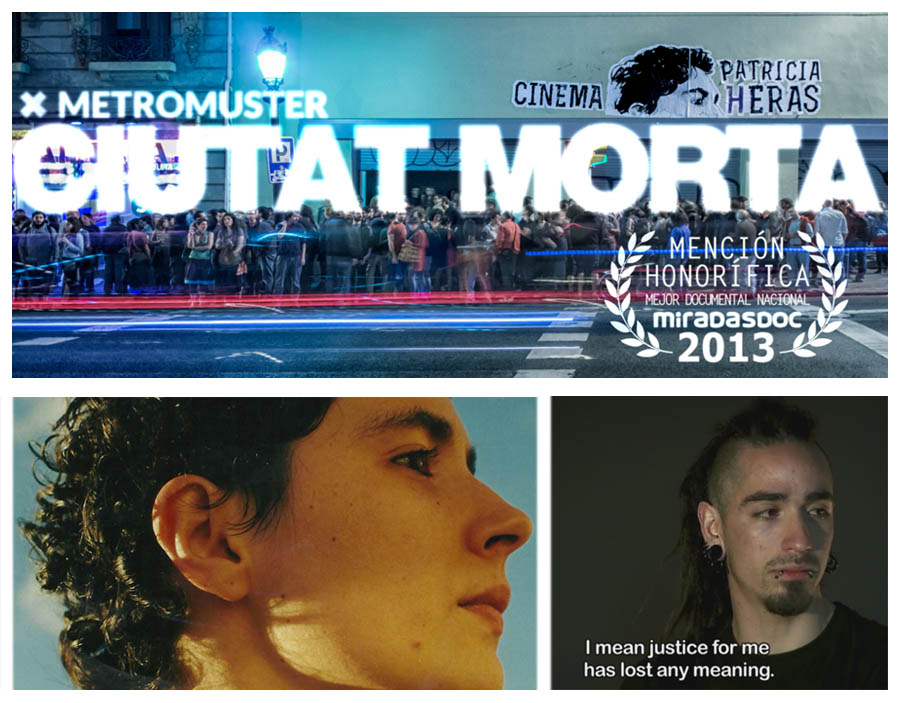
police violence


A dead city
 Like chinese boxes, this documentary not only brilliantly shows the institucional and political corruption behind the police-orchestrated hoax known as ‘4F’, which began on February 4th, 2006 in Barcelona’s calle Sant Pere Més Baix, but it also extends in a coil the understanding of horror to wider levels of society: from the police, to the judges, to the press, to social services, to the city council, to gentrification, in brief, to power in itself. Like before Joaquim Jordà’s De Nens (2003), now Ciutat Morta leads us from a particular history to the deep and terrifying comprehension of the general, of society, of the city. To the memory of Patricia Heras, the dead poet.
Like chinese boxes, this documentary not only brilliantly shows the institucional and political corruption behind the police-orchestrated hoax known as ‘4F’, which began on February 4th, 2006 in Barcelona’s calle Sant Pere Més Baix, but it also extends in a coil the understanding of horror to wider levels of society: from the police, to the judges, to the press, to social services, to the city council, to gentrification, in brief, to power in itself. Like before Joaquim Jordà’s De Nens (2003), now Ciutat Morta leads us from a particular history to the deep and terrifying comprehension of the general, of society, of the city. To the memory of Patricia Heras, the dead poet.
- “4F with names and surnames: a reflection on police, the judiciary, the press and the politicians, during the suffocating silence prior to the broadcasting of ‘Ciutat Morta’“, Jesus Rodríguez in La Directa, 21/1/2015
- “Something stinks in Barcelona“, Argelaga review, 27/1/2015
- Two petitions to sign: for the reopening of the case, and for the resignation of the Judge that seems to have written the verdict before holding the trial.
- Webpage of the movie. It is the same producer of No-res: vida y muerte de un espacio en tres actas, on the demolition of Barcelona’s Colònia Castells neighborhood.
- The mayor of Barcelona presents an award for the directors, but they do not take it: ¿how can they accept it from the same hands that have caused all this story?

The ghosts of San Berillo
 Different cities follow one another on the same site and under the same name, writes Italo Calvino, born and dying without knowing one another, without communication among themselves. At time even the names of the inhabitants remain the same, and their voices’ accent, and also the features of the faces; but the gods who live beneath names and above places have gone off without a word and outsiders have settled in their place. It is pointless to ask whether the new gods are better or worse than the old, since there is no connection between them… We recommend you another Italian documentary movie: Edoardo Morabito and Irma Vecchio’s I fantasmi di San Berillo (2013), first prize at Torino Film Festival. The demolition of this old neighbourhood in the centre of Catania (Sicily), in 1958, was the biggest urban evisceration in post-war Italy, linked (as everything in the country) with Vatican’s Società Generale Immobiliare: 30.000 people where displaced towards the peripheries. It was the same year in which brothels were banned: prostitutes were forced to work underground, and what was left of San Berillo turned into one of the biggest “red light districts” of the Mediterranean. So the story of the neighbourhood went on for another half century, until 2001, when a new police operation evicted again prostitutes and transvestites from their houses and streets. Today many plots are still unoccupied, and some became new favelas (see this 2012 video). The documentary shifts visually from past to present, and the images are associated with the fascinating words of writer Goliarda Sapienza, born in San Berillo in 1924.
Different cities follow one another on the same site and under the same name, writes Italo Calvino, born and dying without knowing one another, without communication among themselves. At time even the names of the inhabitants remain the same, and their voices’ accent, and also the features of the faces; but the gods who live beneath names and above places have gone off without a word and outsiders have settled in their place. It is pointless to ask whether the new gods are better or worse than the old, since there is no connection between them… We recommend you another Italian documentary movie: Edoardo Morabito and Irma Vecchio’s I fantasmi di San Berillo (2013), first prize at Torino Film Festival. The demolition of this old neighbourhood in the centre of Catania (Sicily), in 1958, was the biggest urban evisceration in post-war Italy, linked (as everything in the country) with Vatican’s Società Generale Immobiliare: 30.000 people where displaced towards the peripheries. It was the same year in which brothels were banned: prostitutes were forced to work underground, and what was left of San Berillo turned into one of the biggest “red light districts” of the Mediterranean. So the story of the neighbourhood went on for another half century, until 2001, when a new police operation evicted again prostitutes and transvestites from their houses and streets. Today many plots are still unoccupied, and some became new favelas (see this 2012 video). The documentary shifts visually from past to present, and the images are associated with the fascinating words of writer Goliarda Sapienza, born in San Berillo in 1924.

Taksim halkindir- Taksim belongs to the people!
 “Early in the morning I find Taksim square already full of people and fully operational, among the flags of the left-wing extraparlamentary groups, and of associations of the civil society, from feminists to LGBT, from kurdish anarchists to muslim anticapitalists and marxists…” A commentary from our correspondent in Istanbul: [in spanish and italian]
“Early in the morning I find Taksim square already full of people and fully operational, among the flags of the left-wing extraparlamentary groups, and of associations of the civil society, from feminists to LGBT, from kurdish anarchists to muslim anticapitalists and marxists…” A commentary from our correspondent in Istanbul: [in spanish and italian]
[audio: http://periferiesurbanes.org/wp-content/uploads/2013/06/CavBella.mp3|titles=Cav Bella|artists=Grup Yorum]…

The Pinheirinho massacre
 In the morning of january 22nd, 2012, 2000 military police broke into the Pinheirinho settlement in Sao Paulo (Brasil) with helicopters, tanks, horses, tear gases, and began the eviction. Almost 10.000 people had been living there for about 8 yeras; they had just regularized their housing titles. But the eviction was promoted by a company whose director fled the country in 1990 for finantial crimes, and that now needs the land to speculate, keeping them empty. In preparation of 2014 World Cup and 2016 Olympic Games, some 170.000 people are under eviction all around Brasil. Residents of Pinheirinho strenuously resisted the eviction, that ended with 7 dead, and tens of wounded and arrested. Public houses had been promised to the evicted, now stacked in churches or gyms; but "those in charge of building social houses are part of the same bloodthirsty, prejudiced and deceitful elites as the governants..."
In the morning of january 22nd, 2012, 2000 military police broke into the Pinheirinho settlement in Sao Paulo (Brasil) with helicopters, tanks, horses, tear gases, and began the eviction. Almost 10.000 people had been living there for about 8 yeras; they had just regularized their housing titles. But the eviction was promoted by a company whose director fled the country in 1990 for finantial crimes, and that now needs the land to speculate, keeping them empty. In preparation of 2014 World Cup and 2016 Olympic Games, some 170.000 people are under eviction all around Brasil. Residents of Pinheirinho strenuously resisted the eviction, that ended with 7 dead, and tens of wounded and arrested. Public houses had been promised to the evicted, now stacked in churches or gyms; but "those in charge of building social houses are part of the same bloodthirsty, prejudiced and deceitful elites as the governants..."
- Video documentary: "Pinheirinho: a verdade nao mora ao lado", by Coletivo de Comunicadores Populares; and a reflection on the role of independent journalism.
- Brigadas Populares, Justiça Global, Comunidades e Movimentos contra a violência, "Pinheirinho: a first narrative of institutional violence" [PDF]
- More news: Eviction of Pinheirinho settlement [vídeo] :: "Who gained with the massacre?" [article in Brasil Indymedia] :: Ten lies about Pinheirinho [article in OutrasMídias] :: A week after the massacre [artículo] :: Right, state and terror in the case of Pinheirinho [artículo en A arma da crítica] :: Communiqué of Comitês populares de Copa :: A week before the eviction [text Alliance of Inhabitants]
- Dossier: "Big events and human rights violations in Brazil" [download PDF]
- See also the Grupo de Geografía Crítica Radical (GESP)'s webpage, from University of Sao Paulo

Links on protests in Maghreb

- José SÁNCHEZ GARCÍA (2011) “La revolución egipcia: jóvenes, política y sociedad“. (also in italian) Download his thesis “Juventud en sociedades árabes: ¿cómo construyen su identidad?” (2009) in PDF: 1-2-3.
- Issandr EL AMRANI "Why Tunis? Why Cairo?", London Review of Books, 4/2/2011
- Santiago ALBA RICO "Y de pronto, la revolución" Gara, 17/1/2011
- Gabriele DEL GRANDE "The dictatorship south of Lampedusa" Peacereporter, 10/11/2008
- “Insurrection in North Africa: the story so far“ Libcom, 17/1/2011 (in spanish in Indymedia Estrecho and Klinamen)

A competition of ideas against the demolition of a popular neighborhood

Recipes to eliminate poverty in Buenos Aires
 On december 8th, 2010, the Metropolitan and Federal Police attacked the 200 families who had settled in Parque Iberoamericano (Buenos Aires), as if it was an enemy army: the operation ended with two deaths and many injured. Then, the local gobernment and mass media promoted xenophobia, presenting the abandoned park as "squatted" by bolivians and paraguayans linked with drug dealing: so racist groups from the neighborhoods, together with violent hooligans - patotas de barrabravas , close and often directly hired by the local government- continued the job, killing two more of the settlers.
On december 8th, 2010, the Metropolitan and Federal Police attacked the 200 families who had settled in Parque Iberoamericano (Buenos Aires), as if it was an enemy army: the operation ended with two deaths and many injured. Then, the local gobernment and mass media promoted xenophobia, presenting the abandoned park as "squatted" by bolivians and paraguayans linked with drug dealing: so racist groups from the neighborhoods, together with violent hooligans - patotas de barrabravas , close and often directly hired by the local government- continued the job, killing two more of the settlers.